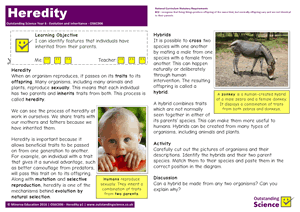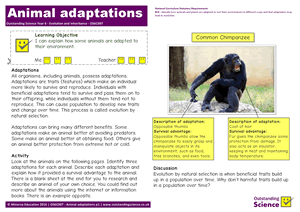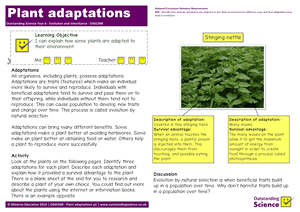

I can model the process of evolution by natural selection.
Children play a game, modelling the process of evolution by natural selection. They use a die to model the effects of predation and mutation. They observe how a population can change over time due to these natural processes. They try to explain how these processed are modelled in the game.
I can explain how Mary Anning contributed to our understanding of fossils.
Children learn about the life and work of the early palaeontologist, Mary Anning. They use what they have learned to create an interview text, imagining themselves as Mary, answering questions such as 'What do your fossils tell us?' and 'Do you think you received enough recognition for you finds?'

2 pages
I can explain what the fossil record tells us about the past.
Children learn what fossils are and how they are formed. They learn how palaeontologists build up a picture of the past using incomplete evidence, most organisms die without leaving a fossil trace. They learn about stratigraphy, and that organisms found in lower layers of rock tend to have died earlier. Children use a diagram showing a simplified cross-section of rock to date 3 different organisms, working out when they appeared, when they died out, and how long they lived for. Children compare the organisms to each other and discuss which lived most recently. Using fossil evidence, children make their best guess at how the animal may have looked when alive, showing this in a diagram.

2 pages
I can explain how Darwin developed the theory of natural selection.
Children read a fictitious autobiography of Charles Darwin. They learn about his early life, his role in the voyage of the HMS Beagle, his relationship with Alfred Russel Wallace, and how he developed and published his theory of natural selection. Children use the information in the autobiography to create their own third-person information text about the life of Charles Darwin.

2 pages
I can explain the process of evolution by natural selection.
Children learn about the process of evolution by natural selection. They learn that offspring inherit traits of their parents, and that they might occasionally carry a random mutation which gives them a survival advantage and that they pass on to their own offspring. They learn that this process can change a population over time. Children use what they have learned to create an explanation text. They cut and paste the diagrams and explanations provided, or create their own.

3 pages
I can identify features that individuals have inherited from their parents.
Children learn that offspring inherit traits from their parents, and that organisms that reproduce sexually combine traits from two parents. Children learn about human-created hybrids. They create a simple family tree for a range of organisms - the labradoodle, the mule, the zonkey and the loganberry, and discuss which traits they have inherited from their different-species parents.

5 pages
I can explain how some animals are adapted to their environment.
Children learn that over time, the process of natural selection can cause a range of beneficial traits (adaptations) to build up in a population. They look at the polar bear, barn owl and penguin, identify three useful adaptations, and explain the survival advantage that they provide. There is also a blank sheet so that children can research another animal's adaptations.

5 pages
I can explain how some plants are adapted to their environment.
Children learn that all organisms possess adaptations, not just animals. Children examine 3 plants - the dandelion, cactus, and Venus fly trap - and identify 3 adaptations for each. There is a blank sheet so that children can research another plant and describe its adaptations.

5 pages